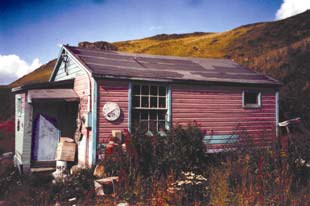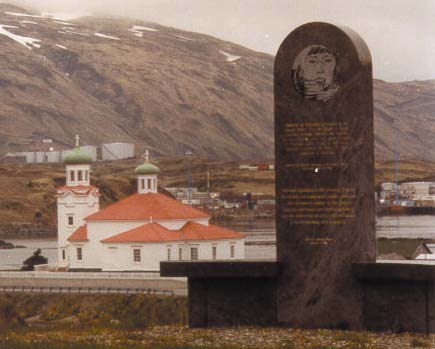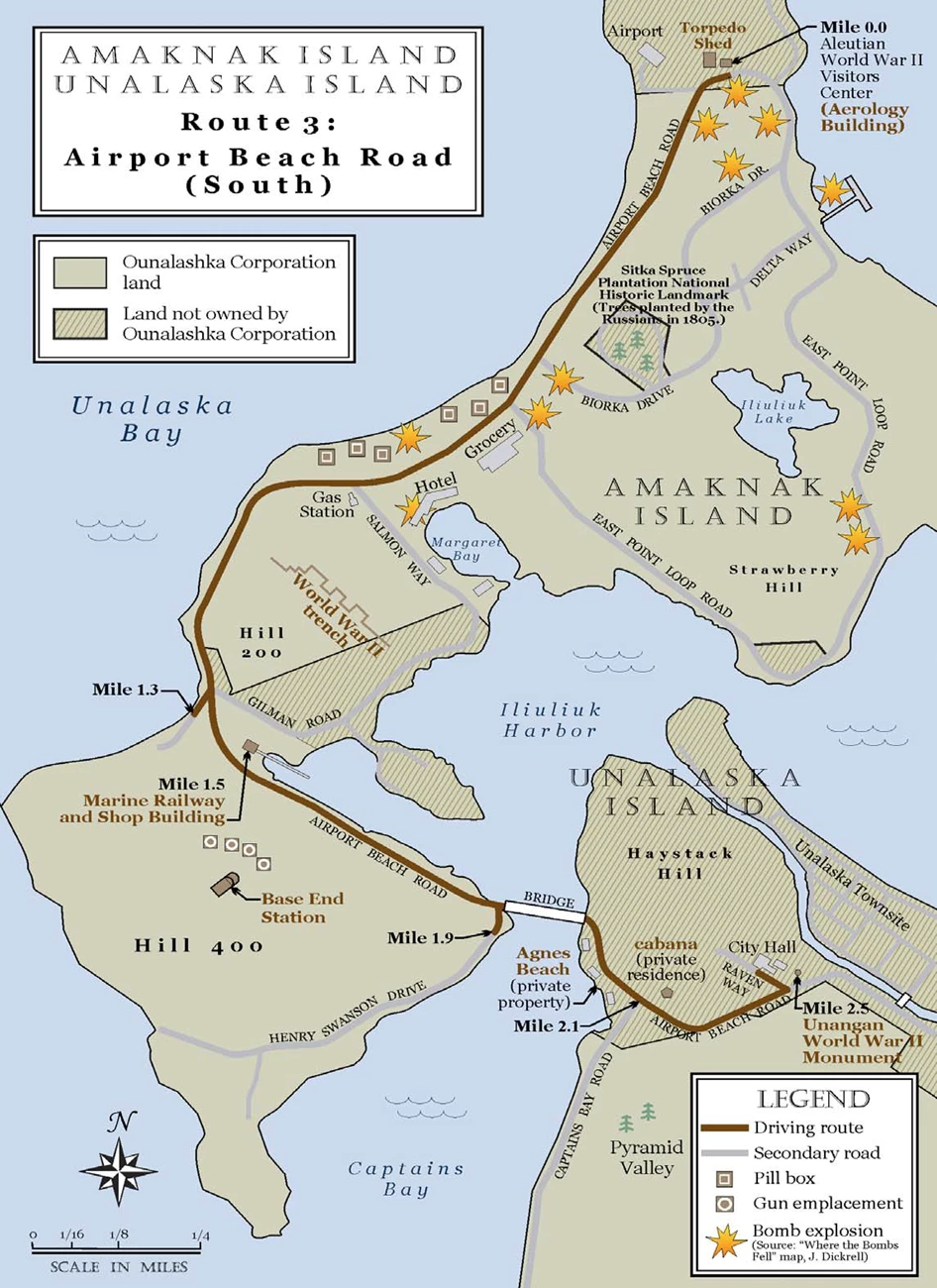Last updated: December 13, 2020
Thing to Do
Airport Beach Road (South)

Turn right out of the Visitor Center parking lot onto Airport Beach Road. At Mile 1.9, turn right onto Henry Swanson Drive, just before the wooden bridge to Unalaska Island. Pull over immediately to left, near bridge. Park facing south. Hill 400 is now on your immediate right; Agnes Beach and Pyramid Valley are on your left, across Captains Bay.
Hill 400 Coastal Defenses, Amaknak Island
Two months after the bombing of Fort Mears, Navy Seabees began constructing a defense installation on Hill 400. Also called Bunker Hill and Little South America (for its geographic shape), Hill 400 overlooks Unalaska Bay, Iliuliuk Harbor, and Captains Bay. This trategic location provided an ideal coastal defense site. Panama mounts for 155-mm guns were installed at the top of Hill 400. Small elephant-steel magazines stored ammunition and fuses; larger concrete-and-steel ordnance magazines were cut into the side of the hill. The two-tiered Base End Station on top of Hill 400 is visible from Airport Beach Road.
Pyramid Valley, Unalaska Island
A concrete power plant is the only structure remaining in the valley where a 50-bed hospital, dental clinic, morgue, warehouses, Quonset huts, and cabanas once stood in 1943. After the war, some cabanas were moved or salvaged for lumber; the rest of the buildings were removed during a 1986 federal environmental cleanup.
The most visible reminders of World War II in Pyramid Valley are the Sitka spruce trees planted during the 1940s as part of a military tree-planting program in the Aleutians. The goal of this program, promoted by General Simon Bolivar Buckner, was to “reduce the monotony of the landscape for thousands of soldiers, …curb erosion, … and rectify Nature’s apparent omissions” (D. Bruce and A. Court: Trees for the Aleutians). Despite the severe winter storms of Southwestern Alaska, a number of the trees planted in this valley have survived.
Hill 400 Coastal Defenses, Amaknak Island
Two months after the bombing of Fort Mears, Navy Seabees began constructing a defense installation on Hill 400. Also called Bunker Hill and Little South America (for its geographic shape), Hill 400 overlooks Unalaska Bay, Iliuliuk Harbor, and Captains Bay. This trategic location provided an ideal coastal defense site. Panama mounts for 155-mm guns were installed at the top of Hill 400. Small elephant-steel magazines stored ammunition and fuses; larger concrete-and-steel ordnance magazines were cut into the side of the hill. The two-tiered Base End Station on top of Hill 400 is visible from Airport Beach Road.
Pyramid Valley, Unalaska Island
A concrete power plant is the only structure remaining in the valley where a 50-bed hospital, dental clinic, morgue, warehouses, Quonset huts, and cabanas once stood in 1943. After the war, some cabanas were moved or salvaged for lumber; the rest of the buildings were removed during a 1986 federal environmental cleanup.
The most visible reminders of World War II in Pyramid Valley are the Sitka spruce trees planted during the 1940s as part of a military tree-planting program in the Aleutians. The goal of this program, promoted by General Simon Bolivar Buckner, was to “reduce the monotony of the landscape for thousands of soldiers, …curb erosion, … and rectify Nature’s apparent omissions” (D. Bruce and A. Court: Trees for the Aleutians). Despite the severe winter storms of Southwestern Alaska, a number of the trees planted in this valley have survived.
Details
Activity
Scenic Driving
Pets Allowed
Yes
Activity Fee
No
Entrance fees may apply, see Fees & Passes information.
Reservations
No
Time of Day
Day
Accessibility Information
This activity is accessible for all visitors with vehicle access. This is intended as a driving guide. Participants can chose their own level of participation and activity.
Agnes Beach and Captains Bay Dock, Unalaska Island
In response to the June 1942 bombing of Fort Mears and Dutch Harbor Naval Operating Base, the military ordered the evacuation of all Unangax̂ people in the Aleutian Islands. Two months later, 189 residents of Unalaska were taken by ship to a relocation camp in Southeast Alaska. During the 2-½ years the Unangax̂ were forced to live in the relocation camp, “there was widespread and wanton destruction of [their] property . . . [by] armed forces personnel and civilians alike” (Military report in The Williwaw War). Furniture and personal items were stolen or vandalized, and plywood ripped from the inside walls of homes.
The residents of Unalaska were allowed to return to their homes in April 1945. When the ship docked just south of Agnes Beach, the people did not realize at first how much their homes had been damaged because Haystack Hill blocked their view of the town. Nick Galaktionoff, who was 20 years old at the end of World War II, described his homecoming in a 1992 interview: “At Unalaska, they unload us at Captain’s Bay dock and from the army truck ”up the valley way. . . by the time we got in the town there it looked bad” (B. Smith, Making It Right, Vol. II). Another Unangax̂ elder remembered “When we came [back] to Unalaska we were happy and we were sad at the same time. Windows [were] broken, doors kicked in, personal belongings were gone. It made you feel like crying whenever someone got to go inside of their homes” (Anfesia Shapsnikoff, 1972 interview in Old Buildings, New Foundations).
In response to the June 1942 bombing of Fort Mears and Dutch Harbor Naval Operating Base, the military ordered the evacuation of all Unangax̂ people in the Aleutian Islands. Two months later, 189 residents of Unalaska were taken by ship to a relocation camp in Southeast Alaska. During the 2-½ years the Unangax̂ were forced to live in the relocation camp, “there was widespread and wanton destruction of [their] property . . . [by] armed forces personnel and civilians alike” (Military report in The Williwaw War). Furniture and personal items were stolen or vandalized, and plywood ripped from the inside walls of homes.
The residents of Unalaska were allowed to return to their homes in April 1945. When the ship docked just south of Agnes Beach, the people did not realize at first how much their homes had been damaged because Haystack Hill blocked their view of the town. Nick Galaktionoff, who was 20 years old at the end of World War II, described his homecoming in a 1992 interview: “At Unalaska, they unload us at Captain’s Bay dock and from the army truck ”up the valley way. . . by the time we got in the town there it looked bad” (B. Smith, Making It Right, Vol. II). Another Unangax̂ elder remembered “When we came [back] to Unalaska we were happy and we were sad at the same time. Windows [were] broken, doors kicked in, personal belongings were gone. It made you feel like crying whenever someone got to go inside of their homes” (Anfesia Shapsnikoff, 1972 interview in Old Buildings, New Foundations).

Because so many of the homes in the town of Unalaska were unhabitable at the end of the war, the Army moved a number of buildings down from Pyramid Valley as temporary housing for the Unangax̂. These 16- by 20-foot wood-frame buildings, called cabanas, were relocated in an area of town between Broadway Avenue and the Iliuliuk River that eventually became known as “New Town.” Moving and remodeling cabanas, as well as salvaging lumber from them, became common practice in Unalaska in the post-war years and in the decades to follow. Many of these cabanas are still in use as housing.
Please respect the privacy of residents as you drive past these homes.

Turn left at Raven Way. Pull into City Hall parking lot and walk up a short path to the top of the knoll overlooking Iliuliuk Bay.
This stone monument was erected as a memorial to the Unangax̂ people who sacrificed their homes and their lives during the war. In 1988, Congress passed An Act Concerning War-Time Relocation of Civilians (Public Law 100-383). This act acknowledged the injustices and unreasonable hardships endured by the Unangax̂ people of the Aleutian Islands (Smith: A Sure Foundation). In 1989, Congress authorized reparation payments to each of the 400 survivors of the internment camps.

